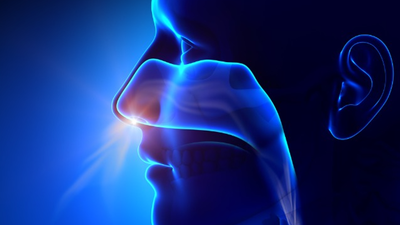Breathing is one of the most vital components of human physiology. The respiratory system brings in oxygen for energy production by inhaling and disposes of carbon dioxide as waste by exhaling. Although the human body can breathe either through the nose or through the mouth, your dominant breathing method might drastically shape your health and fitness level.
Nasal breathing has four major health benefits:
Your nose hairs, cilia, and mucous membrane act as an air filtration system by preventing allergens, pollutants, viruses, and bacteria from entering into your throat and lungs (1).
Your nose both warms and humidifies incoming air to facilitate efficient absorption of oxygen by the lungs (2).
Nasal breathing stimulates the production of nitric oxide to vasodilate your blood vessels which can improve circulation, lower blood pressure, reduce inflammation, and improve your athletic performance (2) (3).
Nasal breathing can help facilitate optimal breathing patterns, leading to parasympathetic activation, increased oxygen uptake, improved lung volume, better respiratory function, improved cardiovascular health, and deeper uninterrupted sleep (4) (5). All of these benefits of nasal breathing stem from its ability to expel more carbon dioxide and therefore, you are able to get more oxygen into your cells.
According to Dental Logic, an estimated 30-50% of adults breathe exclusively through their mouth. There are many reasons why this may be the case, such as nasal congestion or cavity obstruction due to allergies, inflammation, or a deviated septum. Behaviors such as smoking, vaping, or conditions like asthma, pneumonia, anxiety, or obesity can also lead to a greater reliance on mouth breathing (6). There is nothing inherently wrong with mouth breathing since your body will naturally breathe from the mouth when you require more oxygen. However, perpetual mouth breathing can lead to chronic overbreathing which can have some serious detrimental effects (7).
Chronic Mouth breathing brings in unfiltered air which can lead to higher occurrences of allergic reactions, bacterial infections, and illnesses (8). When you mouth-breathe, your mouth rapidly loses moisture which can lead to poor oral health such as dry mouth, bad breath, tooth decay, gum inflammation, cold sores, and/or dehydration (9) (10). Mouth breathing brings in cooler air, making it harder for your lungs to fill and absorb oxygen (11). Also, breathing in cold winter air through the mouth can signal your brain to narrow heart coronaries which can have serious consequences for those with high blood pressure or heart disease (12) (13). Mouth breathing does not stimulate any vasodilation which causes more stress and less circulation which can lead to brain fog and fatigue (14) (15). It can also greatly disrupt sleep by decreasing both deep sleep and REM because mouth breathing increases sleep disturbances such as nighttime urination, snoring, or even sleep apnea (16). Another connection with mouth breathing is an increased risk of developing diabetes and heart disease, most likely because of the sleep disruption (17).
If you find yourself regularly mouth breathing, here are some simple tips to help open up your nasal pathways and become a nasal breather.
Get your ears, nose, and throat checked by a medical professional or ENT specialist professional to ensure that your respiratory system is working properly. An estimated 20 million Americans suffer from a narrowing of the nasal airway.
Clean your nose and sinuses using doctor recommended over-the-counter nasal sprays, saline solutions, or decongestants.
Unclog your sinuses through the use of a menthol-based salves, warm compress, steamy shower, hot bath, or humidifier. The heat can help warm the nasal cavity, loosening mucus and alleviating inflammation.
Massage your sinuses. Using your fingers to apply pressure next to your nose between your cheekbones and jaw. Move your fingers in a circular motion while breathing through your nose to see if you can open up your nasal passage. For a more advanced technique, gently pinch, lift, or rub the bridge of your nose while nasal breathing to manually open up your airways. If this works, you can buy nasal strips to help you breathe while you sleep or exercise.
Adjust your sleeping position. Altering your pillow height can lead to better spinal alignment and better airflow by preventing fluid build up in your sinuses.
If your sinuses are clear, but you are still not breathing through your nose, then adding breathwork to your daily routine can greatly help you switch from oral breathing to nasal breathing. Breathwork is simply about consciously controlling your breath in a relaxed manner. You may find nasal breathing difficult at first, but as you practice, your nasal tissue will start to vasodilate, making it easier to breathe through your nose. Here is a progression of breathing techniques to master nasal breathing for your health and maximization of athletic performance.
Easy Nose Breathing
This is the simplest way to practice nasal breathing. First, find a comfortable place to sit. Second, close your mouth, and start breathing through your nose as gently and quietly as possible. Third, try belly breathing by fully expanding your stomach on the inhale and try to fully expel all the air on the exhale. Fourth, try to slow your breathing as much as possible without straining.
Alternate Nostril Breathing
Many individuals are not able to breathe out of one side of their nose; this yoga breathing technique can help unclog one or both of your nostrils.
- Step 1: find a relaxed body position.
- Step 2: cover and close your right nostril with your right thumb.
- Step 3: exhale completely out of your left nostril.
- Step 4: Inhale fully with your left nostril.
- Step 5: cover and close your left nostril with your right index finger.
- Step 6: exhale completely out of your right nostril.
- Step 7: inhale completely with your right nostril.
- Step 8: Repeat.
Box Breathing
This diaphragmatic breathing technique can help you balance your inhales and exhales while slowing your heart rate and activating your parasympathetic nervous system.
- Step 1: while slowly inhaling through your nose, count four heart beats.
- Step 2: while holding the air from the inhale, count another four heart beats.
- Step 3: While slowly exhaling, count four heart beats again.
- Step 4: wait to inhale for your final four heart beats.
- Step 5: Repeat for 5-10 sets. Using your heart beats instead of counting seconds will naturally increase the duration of your breath and eliminate the worry about counting too fast or too slow.
Walking and Exhaling
This technique can teach your body to expel more carbon dioxide while being active. Step 1: take a normal breath in through your nose. Step 2: While slowly breathing out, count how many steps you can take before feeling the need to inhale. Step 3: Repeat, trying to get more and more steps in.
Zone 2 Cardio with Mouth Tape
Many athletes are using a porous tape that covers the upper and lower lip making it more difficult to breathe through the mouth. The athlete will perform submaximal cardio training in order to build nasal breathing capacity which can help increase respiratory efficiency.
Nose Breathing Recovery Protocol
During your High Intensity Interval Training (HIIT), you can implement nasal breathing to train your body to recover more quickly. Step 1: Sprint as hard as you can, breathing through your mouth. Step 2: as you recover for your next interval, breath only through your nose. If you cannot do this, bring the intensity of the working interval down. This protocol will increase blood oxygen saturation by eliminating carbon dioxide.
Exhaling to Prevent Cramping
Many endurance athletes may feel that their muscles are starting to cramp because the body is not oxygenating their muscles. This could be happening because the person is overbreathing, causing an imbalance of oxygen and carbon dioxide. Next time you are performing intense exercise and breathing heavily through the mouth, try to blow all of the air out of your lungs to expel the carbon dioxide build up and see if it alleviates the fatigue in your muscles. As you flush out carbon dioxide, your body can more efficiently regulate breathing, optimize blood flow, more fully oxygenate your muscles, and maintain optimal pH levels in your muscle tissue for better overall performance.
Hopefully you will implement these nasal breathing techniques into your routine in order to maximize your immune system, obtain higher oxygen absorption, increase vasodilation by stimulating nitric oxide, perform at a higher level through expelling more carbon dioxide, and improve your overall health.
References

